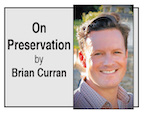YIMBYs vs Preservationists: Roundtable suggests uneasy détente
 Hot on the heels of recent community discussions on two proposed ED1 (Mayor Bass’ Executive Directive 1) affordable housing projects in Larchmont Village at 507 N. Larchmont Blvd. and in the Windsor Village Historic Preservation Overlay Zone (HPOZ) at 800 S. Lorraine Blvd., the federal Advisory Council on Historic Preservation (ACHP) held a Housing and Historic Preservation Roundtable at City Hall on Feb. 22. The roundtable was to discuss the ACHP’s new Housing and Historic Preservation Policy Statement and to identify opportunities to implement its principles through local and statewide approaches.
Hot on the heels of recent community discussions on two proposed ED1 (Mayor Bass’ Executive Directive 1) affordable housing projects in Larchmont Village at 507 N. Larchmont Blvd. and in the Windsor Village Historic Preservation Overlay Zone (HPOZ) at 800 S. Lorraine Blvd., the federal Advisory Council on Historic Preservation (ACHP) held a Housing and Historic Preservation Roundtable at City Hall on Feb. 22. The roundtable was to discuss the ACHP’s new Housing and Historic Preservation Policy Statement and to identify opportunities to implement its principles through local and statewide approaches.
Participants were divided evenly between preservation officials / advocates and YIMBY (Yes In My Back Yard) scholars and champions.
The former included California State Historic Preservation Officer (SHPO) Julianne Polanco, Los Angeles Office of Historic Preservation Principal Planner Ken Bernstein and Los Angeles Conservancy President and CEO Adrian Scott Fine. From the wide-open-development side were Terner Center for Housing Innovation Policy Director David Garcia, UCLA Lewis Center Housing Initiative Project Manager Shane Phillips and Local and Regional Policy Programs Director for CAL YIMBY Aaron Eckhouse. ACHP Chair Sara C. Bronin and ACHP Policy and Legislative Affairs Committee Chair Charles “Sonny” Ward moderated the discussion.
Tension in the room
There was a distinct tension in this arrangement as team YIMBY which, having wrested the machinery of state government to override community planning interests and weakened local control, had to reckon for the first time with the institutional strength of historic preservation at the federal, state and local levels.
The policy statement under discussion presented common sense steps seeking to encourage preservation solutions in solving the housing crisis, such as adaptive reuse of commercial buildings as well as consideration of historic resources even in planning review expedited to encourage development. In the zero-sum thinking of the YIMBY camp, such nuance is rather a foreign concept. In that movement’s public posturing, historic preservation is framed as elitist; neighborhood “character” is mocked; historic houses and buildings are seen as impediments to greater density; and historic districts reinforce inequity.
The discussion started with the topic of the adaptive reuse of historic commercial buildings. That is a strategy, Ken Bernstein pointed out, at which Los Angeles has excelled. Park Mile in our community is now seeing a number of these projects. Bernstein also pointed out that, in post-pandemic Los Angeles, there exist the equivalent of 30 City National Plazas of vacant commercial space in the city, a seemingly enormous opportunity for new housing. Challenges to such adaptive reuse include high property costs, floor plates that may be too deep and the need for seismic upgrades. David Garcia of UC Berkeley’s Terner Center said that financial incentives would have to be provided to overcome these issues to allow new projects to pencil out, particularly for affordable projects.
Dissension
The discussion found its fault line on the topic of historic districts and older neighborhoods. Adrian Scott Fine of the Los Angeles Conservancy called for the protection of naturally occurring affordable housing, i.e. historic apartments; and he asked, “How do we further densify historic neighborhoods without hurting communities?” Ken Bernstein suggested design guidelines were the best tool, however city planners’ hands have been tied due to state legislation such as Senate Bill (SB) 330, which prohibited anything but objective design standards. Bernstein did mention, cheerfully, that 500 permits had been granted for ADUs (Accessory Dwelling Units) in the 35 HPOZs in Los Angeles, a vital source of new housing.
Shane Philips of the UCLA Lewis Center would give no quarter to the idea of design guidelines, “You can’t have it all,” he said. “These are competing interests. Beautifully designed or affordable.”
SHPO Julianne Polanco pointed out that “if preservation is a community value, we need to learn to work together.” Aaron Eckhouse of CAL YIMBY responded that perhaps some exemptions would be appropriate. However, he said, a much more critical view of what we preserve would be required.
ACHP Chair Bronin suggested that maybe cities could be given a “land budget,” an allocation of land set aside for preservation, to which UCLA’s David Garcia responded that this might work if cities had better data to help understand opportunities for adaptive reuse and quantify the amount of land and structures that are currently designated. (Los Angeles actually has such a tool in its own Historic Places LA database, which identifies all recorded historic resources and potential districts.)
Not encasing in amber
The discussion concluded with the basic understanding that historic preservation was a community value that had to be taken into account in the planning and development of new housing. However, YIMBYs argued that since the majority of historic resources were centrally concentrated in areas with the best transit and resources, flexibility is required. Historic districts should not be “frozen,” they argued, so as to allow different housing types that would be sympathetic to their historic environments.
A concession of sorts, but it neglected once again to grapple with the issue of design guidelines, which would be necessary for such development to be integrated successfully.
It was an interesting day that provided much needed “official” response to YIMBYs’ usual caricatures of preservationists and the preservation community. Let’s hope it leads to further discussion and understanding that preservation is about preserving what is best and significant in our city, not encasing it in amber.
The ACHP’s Housing and Historic Preservation Policy Statement can be read here: tinyurl.com/mazu6cu7.
Category: Real Estate
